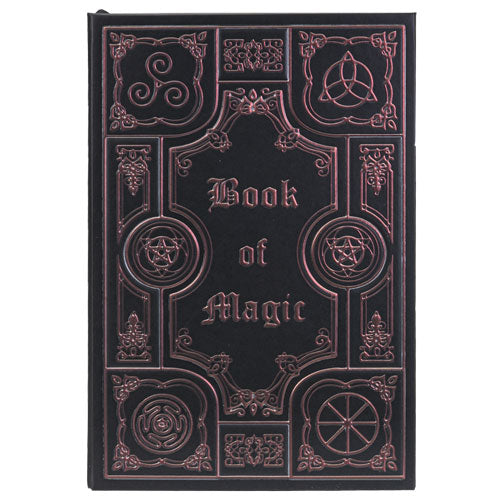
What is a Book of Shadows? Spell Book? Magic Book?
A Book of Shadows (BoS) is a personal and often sacred journal or book used by practitioners of various pagan, Wiccan, and witchcraft traditions to record their magical practices, rituals, spells, beliefs, and experiences. The concept of the Book of Shadows became widely known through the influence of Wicca and other modern pagan movements. The term was popularized by Gerald Gardner, one of the founders of Wicca, and it has since been adopted and adapted by many practitioners.
The contents of a Book of Shadows can vary significantly from person to person and tradition to tradition, but they often include:
1. Spells and Rituals: Instructions for performing magical spells, rituals, and ceremonies. This can range from simple practices to elaborate ceremonies.
2. Correspondences: Information about magical correspondences, such as herbs, crystals, colors, and moon phases, and how they can be used in magical work.
3. Deities and Spirits: Information about deities, spirits, and other entities that a practitioner may work with or honor.
4. Personal Reflections: Personal experiences, thoughts, and insights related to magical practices and spiritual journey.
5. Symbols and Sigils: Symbols, sigils, and diagrams used in magical workings.
6. Herbal and Magical Recipes: Recipes for creating magical oils, incenses, potions, and other concoctions.
7. Divination: Information about divination tools and techniques, such as tarot, runes, and scrying.
8. Ethics and Guidelines: Personal ethical guidelines and principles for the practitioner's magical and spiritual work.
9. Dreams and Visions: Accounts of dreams, visions, and other supernatural experiences.
10. Tradition-Specific Information: Information specific to the practitioner's tradition or path, including teachings, rituals, and lore.
11. Research and Study Notes: Notes from research on various topics related to magic, spirituality, history, and mythology.
The Book of Shadows serves as a repository of knowledge, a record of growth, and a tool for future reference. It can be handwritten, digitally kept, or a combination of both. Some practitioners may keep their Book of Shadows private, while others may share selected portions with trusted individuals or within their community.
It's important to note that the concept and use of the Book of Shadows can vary widely among practitioners. Its significance, content, and practices may differ depending on the individual's beliefs and chosen path.
How to Create your own Book of Shadows
Using a blank Book of Shadows (BoS) involves personalizing and filling it with your magical practices, rituals, spells, and experiences. Here's a step-by-step guide on how to effectively use a blank Book of Shadows:
1. Choose the Right Book:
Select a blank book that resonates with you aesthetically and emotionally. It can be a traditional bound book, a journal, a notebook, or even a digital document if you prefer.
2. Determine Your Organization:
Decide how you want to organize your Book of Shadows. You might use sections, dividers, or different notebooks for different types of content (spells, rituals, research, reflections, etc.).
3. Title and Dedication:
Start your Book of Shadows with a title page that reflects its purpose. You can include a dedication or statement of intention, expressing your commitment to your magical practice.
4. Table of Contents:
Create a table of contents at the beginning of your Book of Shadows. As you add content, update the table of contents to make it easier to find specific information.
5. Spells and Rituals:
Write down spells, rituals, and magical practices you want to remember. Include details like ingredients, steps, correspondences, and any personal notes on your experiences.
6. Correspondences:
Document correspondences for herbs, crystals, colors, moon phases, and more. This information can be useful when planning spells and rituals.
7. Personal Reflections:
Write about your personal experiences, insights, and thoughts related to your magical journey. Reflect on the outcomes of spells, rituals, and divination sessions.
8. Deities and Spirits:
If you work with deities, spirits, or other entities, record information about them, your interactions, and any offerings you make.
9. Symbols and Sigils:
Include symbols, sigils, and diagrams that are meaningful to your practice. Explain their significance and how you use them.
10. Ethics and Guidelines:
If you have personal ethical guidelines or rules for your magical practice, jot them down for reference.
11. Herbal and Magical Recipes:
Document recipes for oils, incenses, potions, and other magical concoctions. Include ingredients, preparation instructions, and any precautions.
12. Divination and Dreams:
Record your experiences with divination tools like tarot cards, runes, or scrying. Also, write about significant dreams, visions, and insights you've had.
13. Research and Study Notes:
Keep track of research notes, references, and resources you come across during your studies.
14. Updates and Maintenance:
Regularly update your Book of Shadows as you learn, grow, and practice. Add new spells, revise old ones, and reflect on your experiences.
15. Personalization:
Make your Book of Shadows uniquely yours. Decorate it with artwork, symbols, pressed flowers, and anything that resonates with your practice.
16. Respect and Privacy:
Keep your Book of Shadows in a safe and private place. Consider using codes, symbols, or shorthand for sensitive information if you're concerned about others accessing your book.
17. Regular Review:
Periodically review your Book of Shadows to refresh your memory and reflect on your progress. This can help you refine your practices and adapt them as needed.
Remember, your Book of Shadows is a reflection of your personal journey and practices. There's no right or wrong way to use it—let it evolve as you do. Over time, your Book of Shadows will become a valuable resource and a meaningful record of your magical path.

